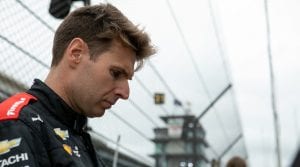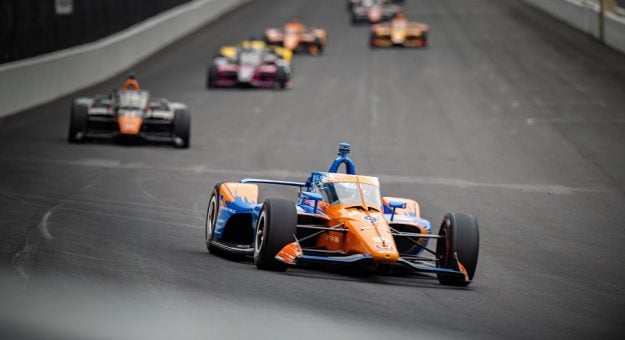INDIANAPOLIS — The fastest field in Indianapolis 500 history will also be one of the tightest fields in recent memory, with the race run on what will be the coolest race day since 2013.
Scott Dixon starts on the pole at the Indy 500 for the fourth time as he attempts to claim an elusive second victory in the fabled race. Dixon’s only Indy 500 triumph came in 2008.
Dixon’s pole-winning four-lap average of 231.685 mph in the No. 9 PNC Bank Honda was just three-one-hundredths of a mile an hour faster than Colton Herta’s 231.655 mph in the No. 26 Gainbridge Honda.
The field average of 230.294 mph is the fastest in Indy 500 history. It is also the third closest field in Indy 500 history by time. The gap between pole winner Dixon and slowest qualifier Dalton Kellett is 2.288 seconds. The record is 1.8040 seconds between pole winner Simon Pagenaud and slowest qualifier Kyle Kaiser in 2019. The second-closest gap is 2.1509 seconds, in 2014.
It’s the sixth-closest field in history, by speed.
When the green flag waves to begin Sunday’s 500-mile classic at 12:45 p.m. ET, the temperature is expected to be 64 degrees. The last time the green-flag temperature was that low came in 2013, when Tony Kanaan won the race.
The early-morning temperature when the gates open at 6 a.m., however, is forecast to be 46 degrees, the coldest temperature to begin a race day since 1989.
What does all of this have to do with the actual racing on the track?
Well, as drivers and teams discovered during Friday’s Carb Day practice, the cooler conditions will make for a track with more grip, giving the speeding cars the ability to use different lanes around the 2.5-mile, four-cornered oval.
During the early days of practice and both days of qualifications, temperatures were in the high 80s with high humidity, making the track slippery and the cars have less grip.
“There’s more of a chance of a lucky outcome if it’s cold,” Dixon said after he was the fastest driver in Friday’s final practice. “I think the weather can change from now till then. It’s going to be cooler; I think. It’s been a while since we’ve had kind of a cool race day.
“If it’s like this, it’s going to be mentally draining because there’s a lot of action going on. You can pass on the front, repass on the back straight. A lot of action going on.
“I’m looking forward to it if that’s the way it plays out. But I think when the pack is a lot tighter, it also has the opportunity for some missteps and maybe some bigger caution periods, things like that. Hopefully, everybody remains safe.”
Conor Daly starts inside row seven and learned a great deal of how his car will work in traffic in the cooler conditions. His Ed Carpenter Racing teammates Rinus VeeKay and Ed Carpenter start third and fourth, respectively.
“I think it was just a much more difficult science project today,” Daly said Friday. “I think when you work toward the days getting hotter and hotter, we thought we made the right moves. I was very happy Sunday afternoon. Sunday afternoon I was like let’s go racing right now.
“Now, I want another four days of practice.”

Team Penske driver Will Power, the 2018 Indy 500 winner and 2014 IndyCar Series champion, starts 32nd, but has a much better race car than that. Power is confident that he can scratch and claw and gouge his way through the field to become a contender late in the race.
“You can’t be too conservative, but you can’t be too aggressive either,” Power explained. “You don’t want to end up in the wall. Just a methodical day. Good pit-stop sequences, maybe fish for a lucky yellow, strategy call like that.
“You can’t force it around this place. You just can’t. You got to get a good balance and get in that rhythm. It’s very difficult to tell if you can pass 32 cars back. Like last year at the start, qualified 24th or something. Yeah, you couldn’t do much at all. It’s a bit more downforce this year, I’m hoping that you can, if you got a bit better car, get through a few cars.
“Starts and restarts will matter, and good pit stops.”
Dixon won’t be surprised when he sees Power’s No. 12 Chevrolet for Team Penske make its way toward the front.
“It will be impressive,” Dixon said. “I honestly felt bad for Will. He’s a fierce competitor. Seeing the struggles, not him, but the team are going through for qualifying pace. He’s probably the greatest qualifier of our era if not all time.
“You definitely know it’s not him, it’s just one of those frustrating things. He handled it extremely well. Kudos for keeping his foot in it, too, which made for some great TV, some great Internet stuff, as well.
“I’ll be in the car, so I won’t be able to watch it. I’m sure at some point we’ll be fighting it out. It should be great.”
There are other numbers to consider entering Sunday’s race.
The last time the pace car was a convertible was in 2008. The winner that year was Dixon.
When Dixon led 111 laps in last year’s race, he went from ninth to third in all-time laps led, passing Bill Vukovich, Parnelli Jones, Emerson Fittipaldi, Wilbur Shaw, A.J. Foyt and Mario Andretti in that category. If Dixon leads 82 laps in Sunday’s race, he will pass Ralph De Palma and Al Unser to become the all-time lap leader in Indy 500 history.
“I only want to lead one lap, and that’s 200,” Dixon said.
If Dixon leads one lap and wins the race, that would tie the record held by Dan Wheldon in 2011.
“OK, that’s a good record,” Dixon said. “I like that record better.”
